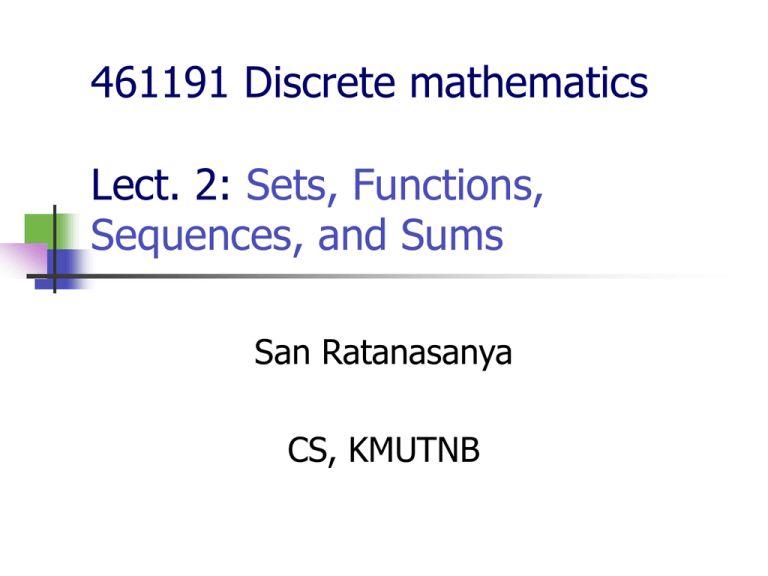DM_lect_2-Chapter 2_1
advertisement

461191 Discrete mathematics
Lect. 2: Sets, Functions,
Sequences, and Sums
San Ratanasanya
CS, KMUTNB
Today’s Topics
Review from last lecture
Proof Strategies
Administrivia
Sets
Functions
Sequences
Sums
Review from last lecture
Rules of Inference
่ ารพิสจ
เป็ นการให ้เหตุผลทีน
่ าไปสูก
ู น์
premises ต ้องเป็ นจริงทัง้ หมดถึงจะสามารถสรุปว่า
conclusion เป็ นจริง
(p1 p2 … pn) c is tautology
Introduction to Proofs
Formal and Informal proof
Direct proof, Indirect proof, Proof By Example, …
Fallacy
Circular Reasoning
First Order (Predicate) Logic
Constant
Predicate
Property that the object has
E.g. Jim is tall tall(jim), สมชายเป็ นพ่อของสมหญิง father(
สมชาย, สมหญิง)
Atomic Sentence
Refers to any object in the world
E.g. สมชาย, Jim
A simplest sentence showing object and property
Argument
A series of sentences in which the last sentence, a conclusion, is
supported by other sentences, premises
The argument is valid if all premises are true, i.e. conclusion is true
Examples of Proof
Prove that
2
is irrational by giving a proof by contradiction
Let p be “√2 is irrational” then ¬p is “It is not the case that √2 is irrational”
which mean √2 is rational. We have to show that ¬p is true leads to contradiction.
√2 is rational means there exist integers a and b with √2 = a/b, where a and b have no
common factors, i.e. a/b is in lowest terms.
2 = a2/b2 2b2 = a2
Since a2 is even, let a = 2c and replace a in the above equation
2b2 = 4c2 b2 = 2c2 b is also even
We have proven that ¬p must be FALSE. Hence, p must be TRUE.
√2 is irrational
Examples of Proof
Proof that 1 = 2
Step
1. a = b
2. a2 = ab
3. a2 – b2 = ab – b2
4. (a - b)(a + b) = b(a - b)
5. a + b = b
6. 2b = b
7. 2 = 1
Reason
Given
Multiply both sides of (1) by a
Subtract b2 from both sides of (2)
Factor both sides of (3)
Divide both sides of (4) by (a – b)
Replace a by b in (5) because a = b
and simplify
Divide both sides of (6) by b
What’s wrong with this proof?!?!?!
More Proof Methods and Strategy
There are some more methods to Proof
Proof Strategies
Exhaustive Proof and Proof by Cases
Existence Proof
Uniqueness Proof
Analyze question to see which method you should use
Try Direct proof
Try Other proof methods
Forward and Backward reasoning
Looking for Counterexamples
We will come back to more Proof in Chapter 4
Administrivia
Lecture notes will be up before class
Please check class webpage on Monday
I will try to up notes by Monday midnight
Be prepared for programming assignments
Prolog, ISETLW
Python, Scheme
Tips to survive in University
Make use of Syllabus
Prepare, prepare, and prepare
Form a group to help each other to learn
Write your own assignment
Activities
Read or study before class
Participate and ask some questions in class
Review and do homework right after class
Group study
To plan your study
Do other activities rather than study only
e.g. work out, sports, meditation, party, etc.
Exams
Review and relax before exam
Do your best on exams
Set
Set
Definition:
A set is an unordered collection of objects.
Fundamental discrete structure
Used to group objects together
Is a Mathematical Data Type
Elements of Set
Definition:
The objects in a set are called the elements, or
members, of the set. A set is said to contain its
elements.
“a is an element of the set A”
เขียนแทนด้วยสัญลักษณ์
aA
“a is not an element of the set A”
เขียนแทนด้วยสัญลักษณ์
aA
ใช้ตวั พิมพ์เล็กแทนสมาชิก (element), ตัวพิมพ์ใหญ่แทนเซต
การแสดง/แจกแจงสมาชิกของเซต
สัญญลักษณ์: { }
ตัวอย่าง
Set V ประกอบด้วยสระในภาษาอังกฤษ
Set O ประกอบด้วยจานวนเต็มบวกที่เป็ นเลขคู่ที่นอ้ ยกว่า 10
V = {a, e, i, o, u}
O = {2, 4, 6, 8}
Set M ประกอบด้วยจานวนเต็มบวกที่นอ้ ยกว่า 100
M = {1, 2, 3, …, 99}
Ellipsis or “ … “ Notation
ใช้ในหลายกรณี เช่น
in English writing
ใช้สาหรับ omitted word, phrase, line, or paragraph
from within a quoted passage
in mathematical notation
mean “and so forth,”
Ex: 1, 2, 3, …, 100
a, b, c, …, z
การเขียนเซตโดยใช้ Set builder
ระบุ property ของสมาชิกแทนการระบุสมาชิกทีละตัว
ตัวอย่าง
Set O ประกอบด้วยเลขจานวนเต็มคู่ที่นอ้ ยกว่า 10
O = { x | x เป็ นจานวนเต็มคู่ที่นอ้ ยกว่า 10}
O = { x | x is an even positive integer less than 10}
O = { x Є Z+ | x is even and x < 10}
Set ที่ใช้บ่อยๆ
เซตของจานวนนับ (Natural numbers)
N = {0, 1, 2, …}
หมายเหตุ natural number อาจหมายถึง
set {0, 1, 2, 3, ...} ใช้ใน logic, set, computer science
set {1, 2, 3, ...} ใช้ใน number theory
เซตของจานวนเต็ม (Integer)
เซตของจานวนเต็มบวก
Z+ = {1, 2, 3, …}
เซตของเศษส่ วน
Z = {…, -2, -1, 0, 1, 2, …}
Q = { p/q | p Є Z, q Є Z and q ≠ 0 }
เซตของจานวนจริ ง: R
จานวนจริ ง
Set ของ Set
สมาชิกของเซตอาจประกอบด้วยเซตอื่นๆ เช่น
A = {N, Z, Q, R}
เซต A ประกอบด้วยสมาชิก 4 ตัว ได้แก่ เซต N, Z, Q และ R
A ={{a}, {b}}
{a} A แต่ a A
การเท่ากันของเซต
Definition:
Two sets are equal if and only if they have the
same elements. That is, if A and B are sets, then
A and B are equal if and only if
x( x A x B)
We write A = B if A and B are equal sets.
การเท่ากันของเซต
{1, 3, 5} และ {3, 5, 1}
สามารถสลับลาดับกันได้
{1, 3, 5} และ {1, 1, 1, 3, 3, 5, 5, 5, 5,}
สามารถเขียนสมาชิกได้มากกว่าหนึ่ งครั้ง
Venn Diagram
Introduced by John Venn in 1881
Universal set (U) contains all the objects under
consideration
Example: เซตของสระในภาษาอังกฤษ
U
V
U: เซตของพยัญชนะภาษาอังกฤษทั้งหมด 26 ตัว
V: เซตของสระในภาษาอังกฤษ
เซตว่าง (Empty Set or Null Set)
ไม่มีสมาชิก
สัญลักษณ์
Ø
{}
เซตของเซตว่าง
เป็ นเซตที่มีสมาชิกเพียงตัวเดียว คือ Ø
เขียนแทนด้วย {Ø}
เทียบได้กบั ลักษณะของโฟลเดอร์ในเครื่ องคอมพิวเตอร์
Subset
Definition:
The set A is said to be a subset of B if and only if every
element of A is also an element of B. We use the
notation
A B
to indicate that A is a subset of the set B
Note: x( x A x B) must be true
Subset
A B
Example: Subset
The set of all odd positive integers less than
10 is a subset of the set of all positive integers
less than 10
A: เซตของจานวนเต็มบวกที่เป็ นเลขคี่ที่มีค่าน้อยกว่า 10
A = {1, 3, 5, 7, 9}
B: เซตของจานวนเต็มบวกที่นอ้ ยกว่า 10
B = {1, 2, 3, 4, 5, 6, 7, 8, 9}
A B
Example: Subset
เซตของนักศึกษาภาค CS เป็ น subset ของ เซตของนักศึกษา
คณะวิทยาศาสตร์
เซตของนักศึกษาคณะวิทยาศาสตร์ เป็ น subset ของ เซตของ
นักศึกษา KMUTNB
กาหนดให้
A: เซตของประชากรที่อาศัยใน กทม.
B: เซตของประชากรที่อาศัยในภาคกลาง
C: เซตของประชากรไทย
A BC
Example: Subset
A={1,2,3,4}
B={1,3}
C={2,4}
D={1,3,4}
E={1,2,3,4,5}
เซตใดเป็ น subset ของเซตใดบ้าง
Example: Subset
จงหา subset ของเซต A={1,2,3}
Ø, {1}, {2}, {3}, {1,2}, {1,3}, {2,3}, {1,2,3}
จงหา subset ของเซต A={ {1}, {2} }
Ø, { {1} }, { {2} }, { {1}, {2} }
ข้อสังเกต {1} ไม่เป็ น subset ของ A
Subset
Theorem
For every set S,
(i) Ø S
(ii)
and
S S
เซตที่ไม่ใช่เซตว่าง จะมี subset สองตัว
พิสูจน์
พิสูจน์วา่ Ø
S
ต้องแสดงให้เห็นว่า
x( x Ø x S ) เป็ นจริ ง
เนื่องจาก Ø ไม่มีสมาชิก ดังนั้น
x Ø
ดังนั้นจึงสรุ ปได้วา่ x( x Ø
x Sเป็) นจริ ง
Vacuous Proof
เป็ นเท็จ
Proper Subset
A เป็ น proper subset ของ B เมื่อ
A ≠ B และ
AB
สัญลักษณ์ของ proper subset
AB
วิธีการตรวจสอบ proper subset:
ต้องหาสมาชิก x ในเซต B ที่ไม่เป็ นสมาชิกของเซต A
Proper Subset
AB
Subset and Superset Relations
ST (“S is a subset of T”) means that every
element of S is also an element of T.
ST x (xS xT)
S, SS.
ST (“S is a superset of T”) means TS.
Note S=T ST ST.
S
/ T means (ST), i.e. x(xS xT)
Proper (Strict) Subsets & Supersets
ST (“S is a proper subset of T”) means that
ST but
for ST.
T./Similar
S
Example:
{1,2}
{1,2,3}
S
T
Venn Diagram equivalent of ST
การเท่ากันของเซต
เราจะสามารถบอกว่าเซต A เท่ากับเซต B ได้เมื่อ
1. A B
และ
BA
2. หรื อสามารถเขียนได้ในรู ป
x(x A x B)
และ
3. หรื อ
x(x B x A)
x(x A x B)
จานวนสมาชิกในเซต
Definition:
Let S be a set. If there are exactly n distinct
elements in S where n is a nonnegative
integer, we say that S is a finite set and that
n is the cardinality of S. The cardinality of S
is denoted by |S|.
จานวนสมาชิกของ Ø หรื อ |Ø| คือ 0
Example
กาหนดให้ A เป็ นเซตของจานวนเต็มบวกที่เป็ นเลขคี่ที่มีค่าน้อย
กว่า 10
สมาชิกของ A คืออะไร
1, 3, 5, 7, 9
จานวนสมาชิกของ A หรื อ |A| คือเท่าไหร่
|A| = 5
Example
กาหนดให้ B เป็ นเซตของตัวอักษรภาษาอังกฤษ (สนใจเฉพาะ
ตัวพิมพ์เล็ก)
สมาชิกของ B คืออะไร
a, b, c, …, z
|B| คือเท่าไหร่
|B| = 26
Infinite Set
Definition:
A set is said to be infinite if it is not finite.
ไม่สามารถบอกจานวนสมาชิกในเซตได้ เช่น
เซตของจานวนเต็มบวก
เซตของจานวนดาวบนฟ้ า
Sets Are Objects, Too!
The objects that are elements of a set
may themselves be sets.
E.g. let S={x | x {1,2,3}}
then S={,
{1}, {2}, {3},
{1,2}, {1,3}, {2,3},
{1,2,3}}
Note that 1 {1} {{1}} !!!!
Power Set
Definition:
Given a set S, the power set of S is the set of all
subsets of the set S. The power set of S is
denoted by P(S).
Example
What is the power set of the set {1,2}?
Subset ของ {1,2} คือ
Ø, {1}, {2}, {1,2}
ดังนั้น
P( {1,2} ) = { Ø, {1}, {2}, {1,2} }
Example
จงหา Power set ของ Empty: P(Ø)
subset ของ Ø คือ
P(Ø) = {Ø}
Ø
จงหา Power set ของ {Ø}: P( {Ø} )
P({Ø}) = {Ø, {Ø} }
Ordered n-tuples
For nN, an ordered n-tuple or a
sequence of length n is written (a1, a2, …,
an). The first element is a1, etc.
These are like sets, except that duplicates
matter, and the order makes a difference.
Note (1, 2) (2, 1) (2, 1, 1).
Empty sequence, singlets, pairs, triples,
quadruples, quintuples, …, n-tuples.
Cartesian Product
Definition:
Let A and B be sets. The Cartesian product of A
and B, denoted by A x B, is the set of all
ordered pairs (a,b), where
a A
and b B . Hence,
A B {(a, b) | a A b B}
Example
A={1,2}
B={a,b}
What is the Cartesian product A x B?
A x B = { (1,a), (1,b), (2,a), (2,b) }
What is B x A?
B x A = { (a,1), (a,2), (b,1), (b,2) }
AxB≠BxA
Example
A={1,2}
B={3,4}
C={5,6}
What is the Cartesian product A x B x C?
A x B x C = { (1,3,5), (1,3,6), (1,4,5), (1,4,6),
(2,3,5), (2,3,6), (2,4,5), (2,4,6)}
Self-test
จงเขียนแสดงสมาชิกของเซตต่อไปนี้
1.
1.
2.
3.
จงระบุจานวนสมาชิก พร้อมทั้งแจกแจงสมาชิกของเซตต่อไปนี้
2.
1.
2.
3.
3.
4.
5.
เซตของจานวนนับที่หารด้วย 10 ลงตัวแต่มีค่าไม่เกิน 50
เซตของจานวนเต็มบวกที่มากกว่า 1 แต่นอ้ ยกว่า 10
เซตของวันในหนึ่งอาทิตย์
{ {a}, b, c, {0}, {1}, 2}
{ 1, 2, 3, 3, 4, 5}
{ x | x Є Z+ และ x2 < 80}
จงแสดง subset ของ { 2, 4, 6, 8}
จงแสดง Power Set ของ { Ø, {3}, {5} }
กาหนดให้ A = { a, b, c } และ B = { d, e } จงแสดง A x B
Set Operations
Union
Definition:
Let A and B be sets. The union of the sets A
and B, denoted by
A B , is the set that
contains those elements that are either in A or
in B, or in both.
เขียนได้เป็ น A B {x | x A x B}
Union
AB
Example: Union
{ 1, 3, 5 }
= { 1, 2, 3, 5}
{ a, b, c, d}
{ 1, 2, 3 }
{ 1, 2, 4}
= { a, b, c, d, 1, 2, 4}
{ 1, 2, 3}
Ø
{ 1, 2, 3}
= { 1, 2, 3}
{ 1, 2, 3}
= { 1, 2, 3}
Intersection
Definition:
Let A and B be sets. The intersection of the sets
A and B, denoted by A B , is the set
containing those elements in both A and B.
เขียนได้เป็ น
A B {x | x A x B}
Intersection
A B
Example: Intersection
{ 1, 3, 5 }
= { 1, 3}
{ a, b, c, d}
={}
{ 1, 2, 4}
{ 1, 2, 3}
{ 1, 2, 3 }
{ 1, 2, 3}
= { 1, 2, 3}
{ 1, 2, 3}
={}
Ø
จานวนสมาชิก
กาหนด | A | = 3 และ | B | = 3
จงหา | A | + | B |
จงหา | A B |
Example
กาหนด A = { a, b, c } และ B = { a, d, e }
|A|=3
|B|=3
จงหา | A B |
| A B | = 5
สูตร A B | A | | B | | A B |
| A B | = 1
| A B |= 3 + 3 – 1 = 5
| A B |
A = { a, b, c } และ B = { a, d, e }
U
d
b
A
c
a
B
e
Inclusion-Exclusion Principle
How many elements are in AB?
|AB| = |A| |B| |AB|
Example:
{2,3,5}{3,5,7} = {2,3,5,3,5,7} ={2,3,5,7}
Disjoint
Definition:
Two sets are called disjoint if their intersection
is the empty set.
Help, I’ve
Example: the set of even
is disjoint with
odd integers.
been
integers
disjointed!
the set of
Difference
Definition:
Let A and B bet sets. The difference of A and B,
denoted by A – B, is the set containing those
elements that are in A but not in B. The difference
of A and B is also called the complement of B with
respect to A.
A B {x | x A x B}
Difference: A – B
Set Difference Examples
{1,2,3,4,5,6} {2,3,5,7,9,11} =
___________
{1,4,6}
Z N {… , -1, 0, 1, 2, … } {0, 1, … }
= {x | x is an integer but not a nat. #}
= {x | x is a negative integer}
= {… , -3, -2, -1}
Example: Difference
{ 1, 3, 5 } – { 1, 2, 3 }
={5}
{ a, b, c, d} – { 1, 2, 4}
= { a, b, c, d }
{ 1, 2, 3} – { 1, 2, 3}
={}
{ 1, 2, 3} – Ø
= { 1, 2, 3 }
Symmetric Difference
A B is the set containing those
elements in either A or B but NOT in
both A and B
Example
A = {1, 3, 5}; B = {1, 2, 3}
A B = {2, 5}
Complement
Definition:
Let U be the universal set. The complement of
the set A, denoted by A, is the complement of
A with respect to U. In other words, the
complement of the set A is U – A.
A {x | x A}
More on Set Complements
An equivalent definition, when U is clear:
A {x | x A}
A
A
U
จงหาค่าของ
A A
AA AA AA
AU AU
( A)
AA
Set Identities
Set Identities (cont.)
Set Identities (cont.)
Proving Set Identities
To prove statements about sets, of the form
E1 = E2 (where Es are set expressions), here
are three useful techniques:
Prove E1 E2 and E2 E1 separately.
Use logical equivalences.
Use a membership table.
Method 1: Mutual subsets
Example: Show A(BC)=(AB)(AC).
Show A(BC)(AB)(AC).
Assume xA(BC), & show x(AB)(AC).
We know that xA, and either xB or xC.
Case 1: xB. Then xAB, so x(AB)(AC).
Case 2: xC. Then xAC , so x(AB)(AC).
Therefore, x(AB)(AC).
Therefore, A(BC)(AB)(AC).
Show (AB)(AC) A(BC). …
Prove: De Morgan’s Law
Prove that A B A B
วิธีการพิสูจน์: แสดงให้เห็นว่า
A B A B
A B A B
Prove (cont.): แสดงว่า
A B A B
x A B
สมมติ x AดัBงนั้น
นัน่ คือ ((x A) (x B))
ใช้กฎของ De Morgan’s จะได้วา่ (x A) (x B)
หมายถึง (x A) (x B)
หรื อ (x A) (x B)
ดังนั้น x A B
เมื่อ x ที่เป็ นสมาชิกของ A B
ก็เป็ นสมาชิกของ A B
จึงสรุ ปได้วา่ A B A B
Prove (cont.): แสดงว่า A B A B
สมมติ x A ดังBนั้น (x A) (x B)
นัน่ คือ (x A) (x B)
จะได้วา่ (x A) (x B)
จากกฎของ De Morgan: ((x A) (x B))
(x A B)
หรื อ
ดังนั้น x A B
เมื่อ x ที่เป็ นสมาชิกของ A ก็Bเป็ นสมาชิกของ A B
จึงสรุ ปได้วา่ A B A B
Prove (cont.)
ได้แสดงให้เห็นแล้วว่า
A B A B
และ
A B A B
ดังนั้น สรุ ปได้วา่
A B A B
Method 2: การพิสูจน์โดยใช้การใช้ set builder
A B {x | x A B}
Def. of complement
{x | (x (A B))}
Def. of
{x | (x A x B)
Def. of intersection
{x | (x A) (x B)}
De Morgan’s Law
{x | x A x B}
Def. of
{x | x A x B}
Def. of complement
{x | x A B}
Def. of union
A B
Meaning of union
symbol
symbol
A B A B
U
A
B
Method 3: Membership Tables
Just like truth tables for propositional logic.
Columns for different set expressions.
Rows for all combinations of memberships
in constituent sets.
Use “1” to indicate membership in the
derived set, “0” for non-membership.
Prove equivalence with identical columns.
Membership Table Example
Prove (AB)B = AB.
A
0
0
1
1
B AB (AB)B AB
0
0
0
0
1
1
0
0
0
1
1
1
1
1
0
0
Prove A (B C) (A B) (A C)
วิธีการพิสูจน์: แสดงให้เห็นว่า
A (B C) (A B) (A C)
(A B) (A C) A (B C)
1) แสดงว่า
A (B C) (A B) (A C)
xA
xBC
สมมติ x A (B ดังC)นั้น
และ
นัน่ คือ (x A) [(x B) (x C)]
ใช้กฎของ Distribution Law จะได้วา่
[(x A) (x B)] [(x A) (x C)]
ซึ่งหมายถึง (x A B) (x A---def.C)of intersection
หรื อ x (A B) (A---def.C)of union
จึงสรุ ปได้วา่ A (B C) (A B) (A C)
2) แสดงว่า(A B) (A C) A (B C)
สมมติ x (A B) (A C)
ดังนั้น (x A B) (x A---def.C)of union
ตาม def. of intersection จะได ้ว่า
[(x A) (x B)] [(x A) (x C)]
C)]
หรื อ (x A) [(x B) (x---Distribution
Law
A
xBC
ตาม def. of union จะได้วา่ x และ
C) def. of intersection
จึงว่า x A (B ตาม
สรุ ปได้วา่ (A B) (A C) A (B C)
พิสูจน์โดยใช้ Membership Table
Membership Table Exercise
Prove (AB)C = (AC)(BC).
A B C AB (AB)C AC
0 0 0
0 0 1
0 1 0
0 1 1
1 0 0
1 0 1
1 1 0
1 1 1
BC
(AC)(BC)
การกาหนดวงเล็บไม่มีผลกรณี การ union หลายๆ เซตหรื อ
การ intersection หลายๆ เซต
A B C
(A B) C
A (B C)
A B C
(A B) C
A (B C)
Example
กาหนด
A = { 0, 2, 4, 6, 8 }
B = { 0, 1, 2, 3, 4 }
C = { 0, 3, 6, 9 }
จงหา A B C
A B C= { 0, 1, 2, 3, 4, 6, 8, 9 }
จงหา A B C
ABC
={0}
Example 1
กำหนดให้ U = {x|x เป็ นนักศึกษำ}
A = {x|x เป็ นนักศึกษำชำย}
นำงสำวขวัญดำวเป็ นสมำชิกของ A/ หรือ A ?
Example 2
จำกรู ป สมำชิกของเซตคือ จำนวนคน โดย U = {x|x เป็ นคน}
A = {x|x เป็ นผู้ชำย} B = {x|x เป็ นนักศึกษำ} จงหำจำนวนต่ อไปนี้
2.6 นักศึกษาที่ไม่เป็ นผูช้ าย
2.1 คนทั้งหมด 1+2+3+4 = 10 คน
{2, 3} - {2} 3 คน
2.2 คนที่เป็ นเพศหญิง 3+4 = 7 คน
2.7 ไม่เป็ นผูช้ าย และ ไม่เป็ นนักศึกษา
2.3 คนที่ไม่เป็ นนักศึกษา1+4 = 5 คน
{3, 4} {1, 4} 4 คน
2.4 นักศึกษาชาย 2 คน
2.8 เป็ นผูช้ าย หรื อ เป็ นนักศึกษา
2.5 ผูช้ ายที่ไม่เป็ นนักศึกษา 1 คน
{1, 2} {2, 3} 1+2+3 = 6 คน
2.9 ไม่เป็ นผูช้ าย หรื อ ไม่เป็ นนักศึกษา
{3, 4} {1, 4} 3+4+1 = 8 คน
Example 3: Search Engine
กาหนด U = {ไข่, ไก่, เป็ ด, ไข่เป็ ด, ไข่ไก่, ปลา, หมู} จงหาผลของการค้นคา
AND = , OR = , NOT = -, NOT A หมายถึง U - A หรื อ A/
{ไก่, เป็ ด, ปลา, หมู}
{ไข่, เป็ ด, ไข่เป็ ด, ปลา, หมู}
{ไก่, ไข่ไก่}
{ไข่, ไก่, เป็ ด, ไข่ไก่, ปลา, หมู}
{เป็ ด, ไข่เป็ ด}
{ไข่เป็ ด}
{ไข่, เป็ ด, ไข่เป็ ด, ไข่ไก่}
{ไก่, ปลา, หมู}
{ไข่ไก่}
Unions of n -sets
Definition:
The union of a collection of sets is the set that
contains those elements that are members of
at least one set in the collection.
union ของเซต A1, A2, …, An เขียนแทนด้วย
n
A1 A 2 ... A n A i
i 1
Intersections of n -sets
Definition:
The intersection of a collection of sets is the
set that contains those elements that are
members of all the sets in the collection.
intersection ของเซต A1, A2, …, An เขียนแทนด้วย
n
A1 A 2 ... A n A n
i 1
Function
Function
ใช้ในกรณี การกาหนดค่าให้กบั สมาชิกแต่ละตัวในเซตแรกโดยใช้ค่าที่ได้
จากสมาชิกในเซตที่สอง
ตัวอย่าง
เซตของนักศึกษา
{ A, B, C, D, F }
บางครั้งอาจเรี ยกว่า Mapping หรื อ Transformation
Definition of Function
Definition:
Let A and B be nonempty sets. A function f from
A to B is an assignment of exactly one element
of B to each element of A. We write f (a) = b if b
is the unique element of B assigned by the
function f to the element a of A. If f is a
function from A to B, we write
f :A B
วิธีการเขียนฟังก์ชนั
f ( x) x 1
สมชาย
สมนึก
สมใจ
สมหญิง
???
วิธีการเขียนฟังก์ชนั (ต่อ)
Definition 2 of Function
Definition:
If f is a function from A to B, we say that
A is the domain of f and B is the codomain of f. If f
(a) = b, we say that b is the image of a
and a is a preimage of b. The range of f is
the set of all images of elements of A.
Also, if f is a function from A to B, we say that
f maps A to B.
If f is a function from A to B.
A is the domain of f
B is the codomain of f
If f (a) = b
b is the image of a
The range of f is the set of all images of elements of A.
A
B
f
domain
codomain
f :A B
f (a) b
preimage
image
สมชาย
สมนึก
สมใจ
สมหญิง
range
ส่ วนประกอบของฟังก์ชนั
Domain
Codomain
Mapping of elements in the domain to
elements in the codomain
จงหา domain, codomain และ range
สมชาย
สมนึก
สมใจ
สมหญิง
???
Domain: { สมชาย, สมนึก, สมใจ, สมหญิง, ??? }
Codomain: { A, B, C, D, F }
Range: { A, B, C, F }
จงหา domain, codomain และ range
f ( x) x
2
Domain: Z
Codomain: Z
Range: { 0, 1, 4, 9, … }
f :Z Z
การเท่ากันของฟังก์ชนั
ฟังก์ชนั จะเท่ากันเมื่อ
Same domain
Same codomain
Map an element of the domain to the same
element in codomain
Function to R (จานวนจริ ง)
Definition:
Let f1 and f2 be functions from A to R. Then f1 +
f2 and f1f2 are also functions from A to R
defined by
( f1 f 2 )(x) f1 ( x) f 2 ( x)
( f1 f 2 )(x) f1 ( x) f 2 ( x)
Example
ให้ f1 และ f2
f1 ( x) x
เป็ นฟังก์ชนั R R โดยที่
2
จงหาค่าของ f1 + f2
f 2 ( x) x x
2
และ f1f2
( f1 f 2 )(x) f1 ( x) f 2 ( x) x ( x x ) x
2
( f1 f 2 )(x) x ( x x ) x x
2
2
3
2
4
One-to-one Functions
Definition:
A function f is said to be one-to-one, or
injective, if and only if f (a) = f (b) implies that
a = b for all a and b in the domain of f. A
function is said to be an injection if it is oneto-one.
สามารถเขียนได้ในรู ป
ab( f (a) f (b) a b)
One-to-one Function
กาหนดให้
O = { a, b, c, d }
P = { 1, 2, 3, 4, 5 }
f(a) = 4
f(b) = 5
f(c) = 1
f(d) = 3
O
P
Example: One-to-one Function
ฟังก์ชนั Z Z: f(x) = x2 เป็ น one-to-one function
หรื อไม่
ถ้าให้ x = 1 จะได้ f(x) = 12 = 1
ถ้าให้ x = -1 จะได้ f(x) = (-1)2 = 1
นัน่ คือ f(1) = f(-1) แต่ 1 ≠ -1
เพราะฉะนั้นฟังก์ชนั นี้ไม่เป็ น one-to-one
ถ้าเปลี่ยนให้ฟังก์ชนั ข้างต้นเป็ นฟั งก์ชนั Z+ Z ฟังก์ชนั ใหม่น้ ี เป็ น
one-to-one หรื อไม่
เป็ น one-to-one
Onto Functions
Definition:
A function f from A to B is called onto, or surjective, if
and only if for every element b B
there is an element
a A with f(a) = b.
A function f is called a surjection if it is onto.
Remark: A function f is onto if
yx( f ( x) y)
Where the domain for x is the domain of the function and
the domain for y is the codomain of the function.
Example: Onto Function
กาหนดให้ f เป็ นฟังก์ชนั จาก
{ a, b, c, d } ไปยัง
{ 1, 2, 3 } และกาหนดค่า
f(a) = 3
f(b) = 2
f(c) = 1
f(d) = 3
ถ้าเปลี่ยน codomain เป็ น {
1, 2, 3, 4 }
ไม่เป็ น onto function
domain
codomain
Onto Functions
Range = Codomain
สมาชิกทุกตัวใน codomain เป็ น image ของสมาชิกใน domain
Example: Onto Function
กาหนดฟังก์ชนั f: ZZ
ฟังก์ชนั f: f(x) = x2 เป็ น onto function หรื อไม่
ไม่ใช่ เพราะไม่มี x ใดที่ทาให้ x2 = -1 เป็ นต้น
ฟังก์ชนั f: f(x) = x + 1 เป็ น onto function หรื อไม่
เป็ น onto function เพราะสาหรับจานวนเต็ม y ใดๆ จะมี x ที่ทาให้
f(x) = y.
One-to-one? Onto?
One-to-one? Onto?
One-to-one? Onto?
One-to-one Correspondence or
Bijection Function
Definition:
The function f is a one-to-one correspondence,
or a bijection, if it is both one-to-one and onto.
Example: Bijection
Example
กาหนด f: { a, b, c, d } { 1, 2, 3, 4 }
โดยที่ f(a) = 4, f(b) = 2, f(c) = 1 และ f(d) = 3
ฟังก์ชนั f เป็ น bijection function หรื อไม่
f is one-to-one because no two values in the domain
are assigned the same function value.
f is onto because all four elements of the codomain are
images of elements in the domain.
ดังนั้น f เป็ น bijection function.
Bijection? One-to-one? Onto?
Bijection? One-to-one? Onto?
Inverse Functions
Definition:
Let f be a one-to-one correspondence from the set A
to the set B. The inverse function of f is the function
that assigns to an element b belonging to B the
unique element a in A such that f(a) = b. The inverse
function of f is denoted by f -1. Hence, f -1(b) = a
when
f(a) = b.
Inverse Function
Invertible
A one-to-one correspondence is called
invertible because we can define an inverse
of the function.
A function is not invertible if it is not a oneto-one correspondence, because the
inverse of such a function does not exist.
Example
กาหนด f: {a, b, c} {1, 2, 3}
โดยที่ f(a) = 2, f(b) = 3 และ f(c) = 1 จงหา f-1
f เป็ นฟังก์ชนั one-to-one correspondence
f-1(1) = c, f-1(2) = a, f-1(3) = b
Example
กาหนดให้ f : Z Z โดยที่ f(x) = x + 1 จงหา f-1
f -1(y) = y – 1
กาหนดให้ f: R R โดยที่ f(x) = x2 จงหา f-1
ไม่สามารถหา f-1 ได้ เนื่องจาก f ไม่ใช่ one-to-one function
เนื่องจาก f(-2) = f(2) = 4 เป็ นต้น
Adding and Multiplying Functions
Two real-valued function with the same
domain can be added and multiplied
Example: Adding and Multiplying
Functions
f1, f2 are functions from R to R.
f1(x)=x2, f2(x)=x-x2. What are the
functions f1+f2 and f1f2?
(f1 + f2)(x) = f1(x) + f2(x) = x2 + x – x2 = x
(f1f2)(x) = f1(x)f2(x) = (x2)(x – x2) = x3 - x4
Compositions of Functions
Definition:
Let g be a function from the set A to the set B and
let f be a function from the set B to the set C. The
composition of the function f and g, denoted by f ο
g, is defined by
( f g )(a) f ( g (a))
Composition of Functions
f o g ไม่สามารถกาหนดได้
ยกเว้นกรณี ที่ range ของ g เป็ น subset ของ domain ของ f
Example
กาหนดให้
g: {a, b, c} {a, b, c} และ g(a) = b, g(b) = c, g(c) = a
f: {a, b, c} {1, 2, 3} และ f(a) = 3, f(b) = 2, f(c) =1
จงหา f o g และ g o f
fog
(f o g)(a) = f(g(a)) = f(b) = 2
(f o g)(b) = f(g(b)) = f(c) = 1
(f o g)(c) = f(g(c)) = f(a) = 3
gof
ไม่สามารถกาหนดได้ เนื่ องจาก range ของฟั งก์ชน
ั f ไม่ได้เป็ น subset ของ
domain ของฟังก์ชนั g
Example
กาหนดฟังก์ชนั f และ g เป็ นฟังก์ชนั ZZ โดยที่ f(x) = 2x + 3 และ
g(x) = 3x + 2 จงหา f o g และ g o f
(f o g)(x) = f(g(x)) = f(3x + 2) = 2(3x + 2) + 3 = 6x + 4 + 3 = 6x + 7
(f o g)(x) = g(f(x)) = g(2x + 3) = 3(2x + 3) + 2 = 6x + 9 + 2 = 6x + 11
Example
กาหนดให้ f(a) = b และ f-1(b) = a
จงหา (f -1 o f)(a)
(f -1 o f)(a) = f -1 ( f (a)) = f -1(b) = a
จงหา (f o f -1)(b)
(f o f -1)(b) = f ( f -1 (b)) = f(a) = b
The Identity Function
For any domain A, the identity function
I:AA (variously written, IA, 1, 1A) is the
unique function such that aA: I(a)=a.
Some identity functions you’ve seen:
ing with T, ing with F, ing with , ing
with U.
Note that the identity function is both oneto-one and onto (bijective).
Identity Function Illustrations
The identity function:
•
•
•
•
•
•
•
y
•
•
Domain and range
x
Graphs of Functions
We can represent a function f:AB as a
set of ordered pairs {(a,f(a)) | aA}.
Note that a, there is only one pair (a,
f(a)).
For functions over numbers, we can
represent an ordered pair (x,y) as a point
on a plane. A function is then drawn as a
curve (set of points) with only one y for
each x.
Graphs of Functions
A Couple of Key Functions
In discrete math, we frequently use the
following functions over real numbers:
x (“floor of x”) is the largest integer x.
x (“ceiling of x”) is the smallest integer x.
Visualizing Floor & Ceiling
Real numbers “fall to their floor” or “rise to
their ceiling.”
3
.
2
.
Note that if xZ,
.
1
x x &
0
x x
.
1
.
Note that if xZ, 2
.
x = x = x.
.. .
3
1.6=2
1.6
1.6=1
1.4= 1
1.4
1.4= 2
3
3=3= 3
Plots with floor/ceiling: Example
Plot of graph of function f(x) = x/3:
f(x)
Set of points (x, f(x))
+2
3
+3
2
x
Sequences
Sequences
A sequence represents an ordered list of
elements.
Formally: A sequence or series {an} is identified
with a generating function f:SA for some
subset SN (often S=N or S=N{0}) and for
some set A.
If f is a generating function for a series {an},
then for nS, the symbol an denotes f(n), also
called term n of the sequence.
Sequence Example
An example of an infinite series:
Consider the series {an} = a1, a2, …, where
(n1) an= f(n) = 1/n.
Then {an} = 1, 1/2, 1/3, …
Example with Repetitions
Consider the sequence {bn} = b0, b1, … (note
0 is an index) where bn = (1)n.
{bn} = 1, 1, 1, 1, …
Note repetitions!
{bn} denotes an infinite sequence of 1’s and
1’s, not the 2-element set {1, 1}.
Recognizing Sequences
Sometimes, you’re given the first few
terms of a sequence, and you are asked
to find the sequence’s generating
function, or a procedure to enumerate
the sequence.
Examples: What’s the next number?
5 (the 5th smallest number >0)
1,2,3,4,…
1,3,5,7,9,… 11 (the 6th smallest odd number >0)
2,3,5,7,11,... 13 (the 6th smallest prime number)
The Trouble with Recognition
The problem of finding “the” generating function given
just an initial subsequence is not well defined.
This is because there are infinitely many computable
functions that will generate any given initial subsequence.
We implicitly are supposed to find the simplest such
function (because this one is assumed to be most likely),
but, how should we define the simplicity of a function?
We might define simplicity as the reciprocal of complexity, but…
There are many plausible, competing definitions of complexity,
and this is an active research area.
So, these questions really have no objective right answer!
Summations
Summation Notation
Given a series {an}, an integer lower bound
(or limit) j0, and an integer upper bound
kj, then the summation of {an} from j to k
is written and defined as follows:
k
a : a
i j
i
j
a j 1 ... ak
Here, i is called the index of summation.
Generalized Summations
For an infinite
series, we may write:
a : a
i j
i
j
a j 1 ...
To sum a function over all members of a set
X={x1, x2, …}: f ( x) : f ( x1 ) f ( x2 ) ...
xX
Or, if X={x|P(x)}, we may just write:
f ( x) : f ( x ) f ( x ) ...
1
P( x)
2
Simple Summation Example
4
(i
2
1) (2 1) (3 1) (4 1)
2
2
2
i 2
(4 1) (9 1) (16 1)
5 10 17
32
More Summation Examples
An infinite series with a finite sum:
1
1
2
2
2
...
1
2
4 ... 2
i
0
1
i 0
Using a predicate to define a set of
elements to sum over:
2
2
2
2
2
x
2
3
5
7
4 9 25 49 87
( x is prime)
x 10
Summation Manipulations
Some handy identities for summations:
cf ( x) c f ( x)
x
x
x ( f ( x) g ( x)) x f ( x) x g ( x)
k
k n
f (i)
i j
l j n
f (l n)
(Index shifting.)
More Summation Manipulations
m
k
f (i ) f (i) f (i) if j m k
i j
i j
i m 1
k
(Series splitting.)
k
k j
i j
l 0
n
n
i 0
l 0
2k
k
k
i 0
i 0
i 0
f (i) f (k l )
(Order reversal.)
f (i) f (n l )
f (i) f (2i) f (2i 1)
(Grouping.)
Example: Impress Your Friends
Boast, “I’m so smart; give me any 2-digit
number n, and I’ll add all the numbers from
1 to n in my head in just a few seconds.”
n
I.e., Evaluate the summation:
i
i 1
There is a simple closed-form formula for
the result, discovered by Euler at age 12!
Leonhard
Euler
(1707-1783)
Euler’s Trick, Illustrated
Consider the sum (assume n is even):
1+2+…+(n/2)+((n/2)+1)+…+(n-1)+n
…
n+1
n+1
n+1
n/2 pairs of elements, each pair summing
to n+1, for a total of (n/2)(n+1).
Symbolic Derivation of Trick
k n
k n ( k 1)
i i i i i (n l )
i 1
i 1
i 1 i k 1 i 1 l 0
n
2k
k nk
i (n (l 1))
i 1 l 1
order reversal
index shifting
k nk
n/2 n/2
i (n 1 l ) i (n 1 l )
i 1 l 1
i 1 l 1
(k=n/2)
Concluding Euler’s Derivation
n/2 n/2
i (n 1 i)
i 1 i 1
n/2
(i n 1 i)
i 1
n/2
(n 1) n2 (n 1) n(n 1) / 2
i 1
So, you only have to do one easy
multiplication in your head, then cut in half.
Also works for odd n (prove this at home).
Example: Geometric Series
A geometric series is a series of the form
a, ar, ar2, ar3, …, ark, where a,rR.
The sum of such a series is given by:
k
k
S ar a r
i
i 0
i
i 0
We can reduce this to closed form via clever
manipulation of summations...
Geometric Sum Derivation
Here S ari
i 0
we
n
go... rS r ari
n
i 0
n
n
n
i 0
i 0
i 0
i
i
1 i
rar
arr
ar
r
n
n 1
n 1
i 0
i 1
i 1
ar1i ar1 ( i 1) ari
n 1
n
n
i
i
i
ar ar ar ar n 1 ...
i 1
i n 1
i 1
Derivation example cont...
n i
n i
n 1
0
0
rS ar ar (ar ar ) ar ar n 1
i 1
i 1
n
0
i
ar ar ar n 1 ar0
i 1
0 i n i
ar ar ar n 1 a
i 0
i 1
n i
ar a(r n 1 1) S a(r n 1 1)
i 0
Concluding long derivation...
rS S a(r n 1 1)
rS S a(r n 1 1)
S (r 1) a(r n 1 1)
r n 1 1
S a
r 1
when r 1
n
n
n
When r 1, S ar a1 a 1 (n 1)a
i
i 0
i
i 0
i 0
Nested Summations
These have the meaning you’d expect.
3 4 3
ij ij i
i 1 j 1
i 1 j 1
i 1 j 1
4
3
4
4
4
i 1
i 1
4
j i 1 2 3
i 1
6i 6 i 6(1 2 3 4)
6 10 60
Note issues of free vs. bound variables, just
like in quantified expressions, integrals, etc.
More Series
n
k
n 1
ar
a
(
r
1) /(r 1), r 1
k 0
Geometric series
n
Arithmetic Series
k 1
(Euler’s trick)
k n(n 1) / 2
n
2
k
n(n 1)(2n 1) / 6
Quadratic series
k 1
n
3
2
2
k
n
(
n
1
)
/4
k 1
Cubic series
More Series
k
x
1/(1 x),| x | 1 Infinite Geometric
k 0
k 1
2
kx
1/(1
x
)
,| x | 1
k 1
Example
100
Evaluate
Use series splitting.
Solve for desired
summation.
Apply quadratic
series rule.
Evaluate.
2
k
.
k 50
49 2 100 2
k k k
k 1
k 1 k 50
100
100 2 49 2
2
k k k
k 50
k 1 k 1
100101 201 49 50 99
6
6
338,350 40,425
100
2
297,925.
Homework 2
Chapter 2 (Rosen 6th edition)
Section 2.1
Section 2.2
1, 18, 19, 32, 54, 62
Section 2.4
7, 8, 28, 38, 50, 51
Section 2.3
2, 5, 6, 14, 18-20, 28, 29, 36
4, 8, 13, 18, 23, 24, 29, 30, 31, 32
Supplementary
5, 6, 14, 19, 25, 30








